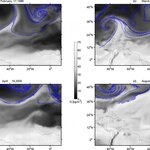Atmospheric

A recalculation of the dates at which boulders were uncovered by melting glaciers at the end of the last Ice Age has conclusively shown that the glacial retreat was due to rising levels of carbon dioxide and other greenhouse gases, as opposed to other types of forces.
Carbon dioxide levels are now significantly higher than they were at that time, as a result of the Industrial Revolution and other human activities since then. Because of that, the study confirms predictions of future glacial retreat, and that most of the world's glaciers may disappear in the next few centuries.
The findings…

Researchers have completed a large-scale research project conducted over a five-year period on the African continent to compile the first greenhouse gas budget of African rivers.
Covering 12 rivers spread across the entire continent of Africa, the study shows that greenhouse gas emissions from the rivers are very significant. The researchers trawled the African continent in order to analyze the streams of carbon dioxide (CO2), methane (CH4) and nitrous oxide (N2O), the three main GHG.
The work draws attention to the important role of wetlands (these include inundated forests, flood plains…

The arrival of intense cold similar to what some call the "Little Ice Age" of the late 17th century and early 18th century, is expected in the years 2030 to 2040, according to a presentation during the National Astronomy Meeting in Wales.
Why so?
The Sun has its own magnetic field and its amplitude and spatial configuration vary with time. The formation and decay of strong magnetic fields in the solar atmosphere results in the changes of electromagnetic radiation from the Sun, of the intensity of plasma flows coming from the Sun, and the number of sunspots on the Sun's surface. It is…

It is well established that volcanic eruptions contribute to climate variability but quantifying those impacts has proven challenging due to inconsistencies in historic atmospheric data observed in ice cores and corresponding temperature variations seen in climate proxies such as tree rings.
A new study in Nature resolves those inconsistencies with a new reconstruction of the timing and associated radiative forcing of nearly 300 individual volcanic eruptions extending as far back as the early Roman period.
The study shows that 15 of the 16 coldest summers recorded between 500 BC and 1,000 AD…

We can use lightning rods to increase the probability of it striking at a specific location but its exact path remains unpredictable.
Perhaps not for long. At a smaller scale, discharges between two electrodes behave in the same manner, streaking through space to create electric arcs where only the start and end points are fixed. Knowing that, it may be possible to control the current so that it follows a predetermined path, say Professor Roberto Morandotti and colleagues from
INRS Énergie Matériaux Télécommunications research centre
who have discovered a way to guide electric discharges -…

High in the sky where the cirrus ice crystal clouds form, jet contrails draw their crisscross patterns. Now researchers have found that these elevated ice cloud trails can influence temperatures on the ground and affect local climate.
For contrails to form, the atmosphere at the level the jet is flying must be cold enough that the moisture from the jet exhaust freezes into ice crystals. There also must be enough moisture in the air that the clouds that form remain in the sky for at least a few hours as persisting contrails.
A team of geographers looked at temperature observations made…

With warming summer temperatures across Alaska, white spruce tree growth in Interior Alaska has declined to record low levels, while the same species in Western Alaska is growing better than ever measured before.
The findings are the result of a study led by University of Alaska Fairbanks School of Natural Resources and Extension researcher Glenn Juday, Claire Alix of the University of Paris 1 Pantheon-Sorbonne, and Tom Grant, formerly an adjunct faculty member at UAF. Their findings were recently published online by the journal Forest Ecology and Management.
'For the first time across a…

If you want to blame something for an overcast day, it's safe to go with the tropics. Water vapor originating from the Earth's tropics is transported to mid-latitudes on long filaments of flowing air that intermittently travel across the world's oceans.
When these airy tendrils make landfall, they can cause severe floods and other extreme weather events. Yet despite the importance of these "atmospheric rivers" for the global water and heat cycles, the mechanism behind their formation is still a mystery.
But a new study, published this week in the journal Chaos, from AIP Publishing,…

In the fickle, unpredictable system that is our climate, it looks like El Niño, which was already said to have came and gone with a whimper months ago by climate scientists, may finally be arriving.
When it happens, we may know by bunny breeding.
At times during the past 10,000 years, cottontails and hares surged when the El Niño weather pattern drenched the Pacific Coast with rain, according to an analysis of 3,463 bunny bones. The number of El Niños per century "correlates very strongly with the total rabbit population in Baja California, as well as relative abundance of the moisture-…

Typhoon Haiyan, which devastated large portions of the Philippines in November 2013, killed at least 6,300 people. It set records for the strongest storm ever at landfall and for the highest sustained wind speed over one minute ever, hitting 194 miles per hour when it reached the province of Eastern Samar.
It could become more common, according to a new model which factored in what controls the peak intensity of typhoons. The model finds that under climate change this century, storms like Haiyan could get even stronger and more common - as much as 14 percent, nearly equivalent to an…